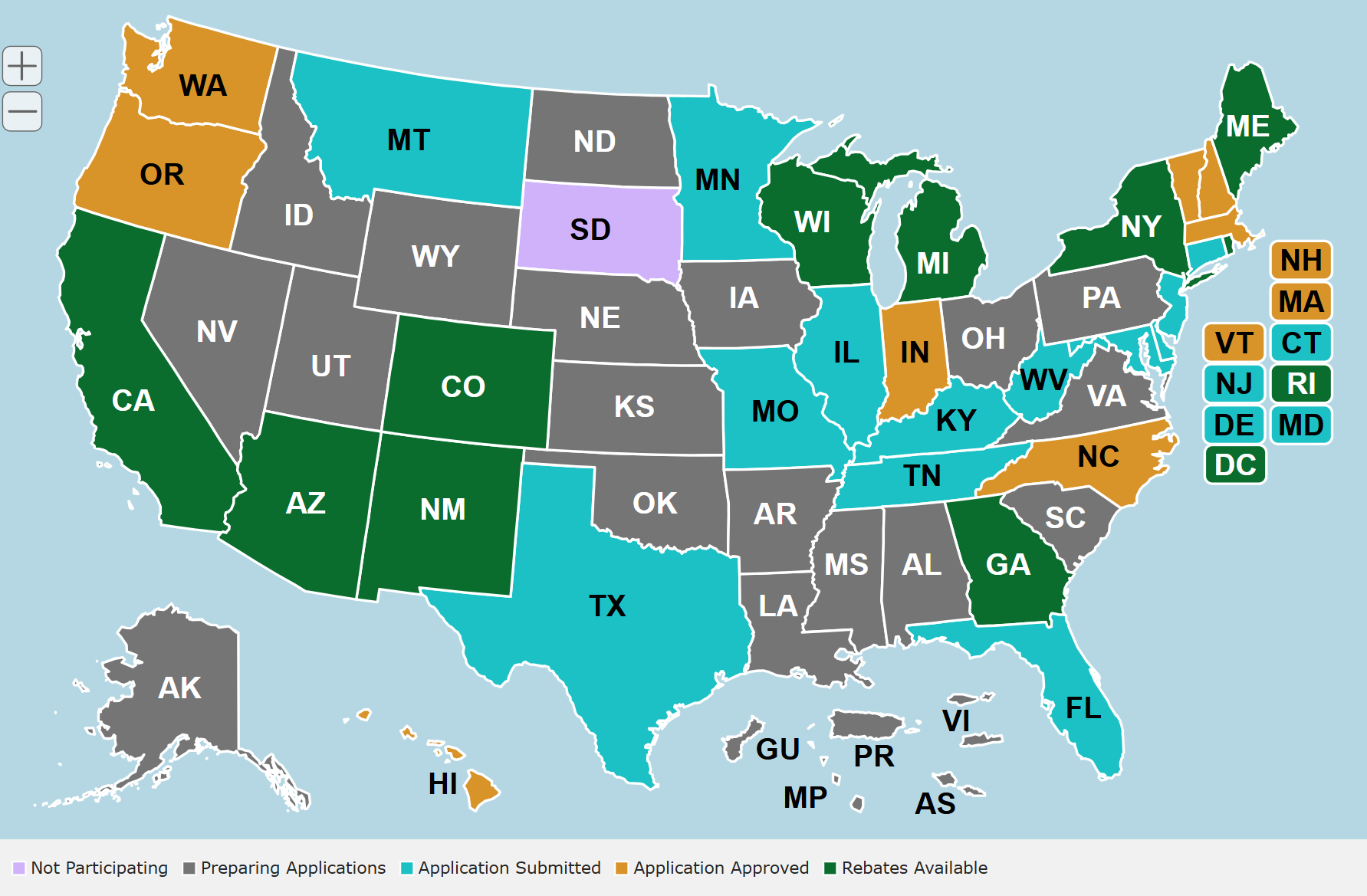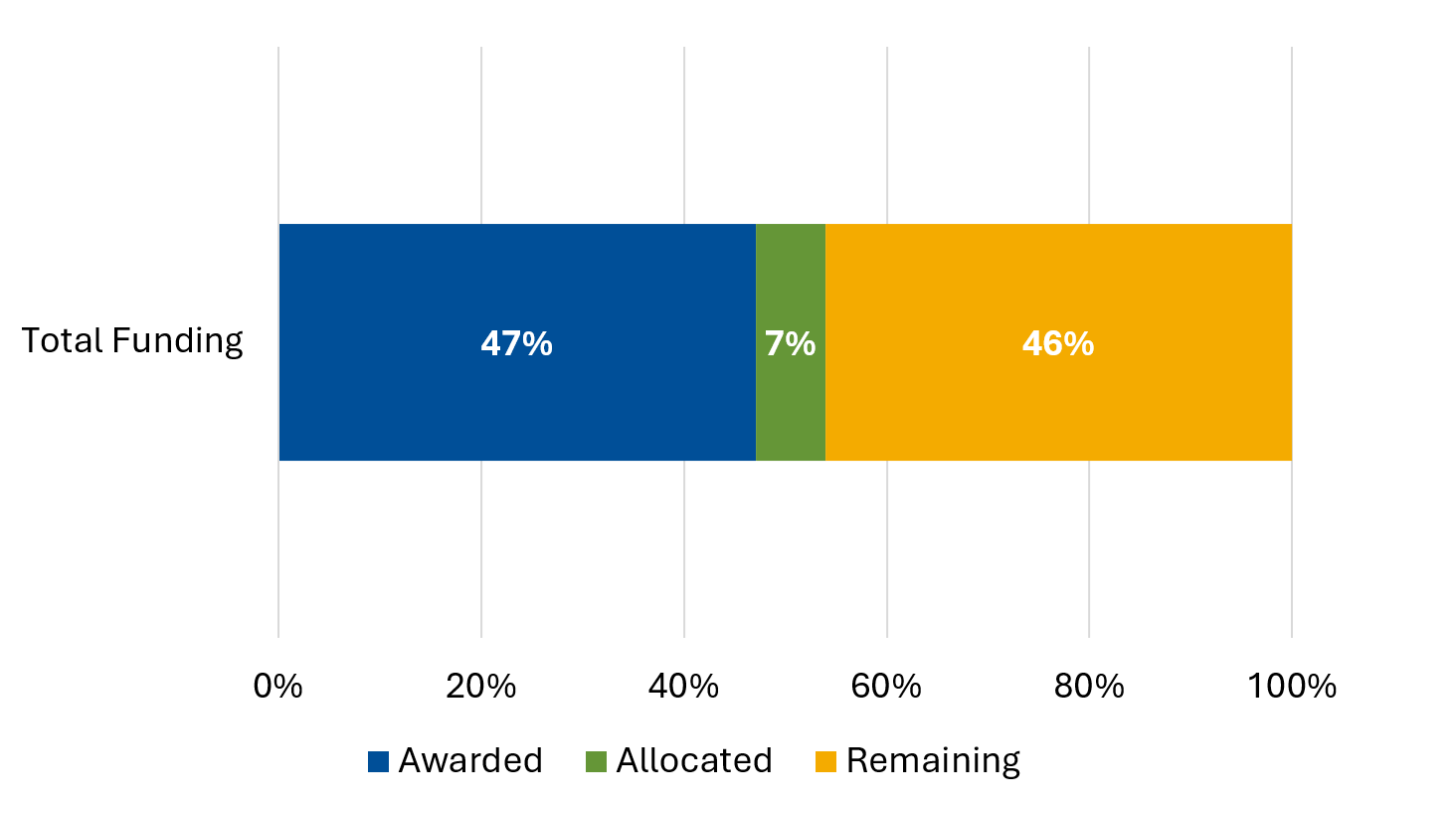
The Inflation Reduction Act (IRA), passed in August 2022, provided nearly $90 billion to 27 programs for residential, commercial, and public building decarbonization and electrification. Two years later, the federal government is getting the money out the door and recipients are standing up programs to make a big dent in greenhouse gas emissions from buildings. Although the 2024 elections introduced uncertainty about the future of federal funding for building decarbonization and electrification, over half the IRA funding for buildings has already been awarded or allocated. Thus far, over $42 billion from these programs have been awarded to a mix of federal agencies, state and local governments, Tribal Nations, non-government organizations (NGOs), and commercial actors, working to decarbonize buildings from all angles of the economy (Figure 1).
Figure 1: Majority of IRA Buildings Funding Has Been Awarded or Allocated
Source: Climate Program Portal.
Most of this funding is coming out of the Department of the Treasury (Treasury, $48 billion), the Environmental Protection Agency (EPA, $35 billion), the Department of Energy (DOE, $18 billion), and the Department of Housing and Urban Development (HUD, $12 billion); the remaining funding is being disseminated by the General Services Administration, the Department of Agriculture, and the Department of the Interior. IRA programs benefitting buildings fall into three major categories: federal tax credits, electrification implementation, and formula funding for state programs.
The largest type of funding is, by far, tax credits. These include the $22 billion Residential Clean Energy Credit (25D), the $12.5 billion Extension, Increase, and Modification of Nonbusiness Energy Property Credit (25C), now called the Energy Efficient Home Improvement Credit, and the $2 billion Extension, Increase, and Modification of New Energy Efficient Home Credit (45L). $362 million in tax credits is also available in the Energy Efficient Commercial Buildings Deduction (179D).
Additionally, $35.1 billion is distributed via competitive grant application processes. $27 billion of this total exists in the Greenhouse Gas Reduction Fund and its three sub-categories: the National Clean Investment Fund, Solar For All, and the Clean Communities Investment Accelerator. Finally, about $10 billion is available via formula grants, most notably through the High-Efficiency Electric Home Rebate Program (HEEHRA) and the Home Energy Performance-Based, Whole House Rebates (HOMES), collectively known as the federal Home Energy Rebates.
Altogether, the IRA infused building electrification and decarbonization efforts with fresh funding, mostly in four key categories: financing, renewable energy, state planning and implementation, and manufacturing supply chains. The rest of this data story will provide illustrative examples and statistics exemplifying the impact of these billions on our building stock in each of these categories.
Financing
Before the IRA, several building-related tax incentives existed but were inconsistent, were renewed in short bursts, and some expired by the time the IRA was up for debate. For example, the 25C Energy Efficient Home Improvement credit was established in 2007 to cover up to 30 percent of installation costs for heating and cooling systems or doors and windows. The amount was adjusted to 10 percent in 2011 and expired in 2017, before being extended at the 10 percent rate to 2021. The IRA gave new life to many tax incentives to implement climate-friendly strategies across the economy and made them accessible to more taxpayers with changes to how they were administered. In the buildings sector, the IRA renewed the 25C Energy Efficient Home Improvement credit, the 25D Residential Clean Energy tax credit, the 30C Alternative Fuel Vehicle Refueling Property tax credit, the 45L New Energy Efficient Home tax credit, and the 179D Energy Efficient Commercial Buildings Deduction (Table 1).
Table 1: Buildings Tax Credits in the Inflation Reduction Act
| Tax Credit | Eligible Claimant | Amount |
| Energy Efficient Home Improvement Credit (25C) | Homeowners | 30 percent of qualifying costs ($3,200) per year, which can include:
|
| Residential Clean Energy Tax Credit (25D) | Homeowners | 30 percent of installation costs for rooftop solar, batteries, and geothermal heating. |
| Alternative Fuel Vehicle Refueling Property Tax Credit (30C) | Homeowners | 30 percent of installation costs for at-home electric vehicle charging infrastructure. |
| New Energy Efficient Home Tax Credit (45L) | Contractors | $500-$5k for energy-efficient new homes or major renovations:
|
| Energy Investment Tax Credit (48)/Clean Electricity Investment Tax Credit (48E) | Commercial building owners | · Until December 31, 2024: 6-30 percent of installation costs for solar, storage, geothermal, or other renewable energy systems (dependent on prevailing wage and apprenticeship requirements).
· Beginning January 1, 2025: 6-30 percent of installation costs for energy generation with zero greenhouse gas emissions or energy storage (dependent on prevailing wage and apprenticeship requirements). |
| Energy Efficient Commercial Buildings Deduction (179D) | Commercial building owners or contractors |
|
Source: Internal Revenue Service.
One of the major changes that the IRA made to clean energy and energy efficiency tax credits was to make them eligible for “elective pay” or “direct pay,” meaning that recipients who do not have enough tax liability to take advantage of the credits can instead receive a payment equal to the credit’s value. This is useful for tax-exempt entities such as state and local governments and non-profit organizations. According to statistics from the Internal Revenue Service, over 1.2 million homeowners claimed the Residential Clean Energy Credit and 2.3 million claimed the Energy Efficient Home Improvement Credit in 2023. Some space heaters and water heaters fueled by gas, oil, or propane are also eligible for the home improvement credit; 577,000 tax returns claimed credits for one of these technologies. By contrast, only about 372,000 tax returns claimed credits for heat pump space or water heaters.
In addition to tax incentives, the IRA created programs to help provide financing for projects. The IRA established the Greenhouse Gas Reduction Fund (GGRF), a $27 billion program designed to catalyze private investment in greenhouse gas reductions. The three segments of the GGRF are the National Clean Investment Fund (NCIF), the Clean Communities Investment Accelerator (CCIA), and the Solar For All program (see the Renewable Energy section below for a discussion of Solar For All). In April 2024, the NCIF awarded $7 billion to the Climate United Fund, a coalition of impact investment groups. 50 percent of the Climate United Fund’s award will be dedicated to decarbonizing buildings. The NCIF awarded $5 billion to the Coalition for Green Capital, a coalition of green banks and similar development authorities, to establish a national green bank. Between 10 and 20 percent of the coalition’s award will go to funding net-zero emissions buildings and another 30 to 40 percent will go to distributed energy generation and storage, which may benefit building decarbonization. The final $2 billion from the NCIF went to Power Forward Communities, a coalition of housing investment groups, to finance building decarbonization projects, build markets for efficient solutions, and engage communities. The entirety of the Power Forward Communities award will go to building decarbonization.
Also in April 2024, the CCIA awarded a total of $6 billion to five community development finance institutions working to help low-income households reduce greenhouse gas emissions: Opportunity Finance Network, Inclusiv, Justice Climate Fund, Appalachian Community Capital, and Native CDFI Network. The workplans of all five institutions mention distributed energy and deep retrofits or net-zero buildings, although some funding will also go to decarbonizing transportation and the grid.
Renewable Energy
A less utilized method of building decarbonization and electrification is installation of on-site renewable energy production technologies, most commonly solar. As of the 2020 Residential Energy Consumption Survey and the 2018 Commercial Energy Consumption Survey, only about three percent of households (four million) and two percent of commercial buildings (93,900 solar panels used) nationwide have installed solar power generation. The IRA introduces $31.2 billion in funding for which on-site renewable energy generation projects qualify.
The largest available sum is the $22 billion from the 25D tax credit for residential clean energy projects. The credit will be active for a decade, providing 30 percent credit values into 2033. To receive the credit, an individual must install any of the following renewable technologies: fuel cells, geothermal heat pumps, small wind systems, solar electric systems, or solar hot water systems. Installation of any of the above is an expensive endeavor; the 30 percent price tag reduction is a solid financial incentive to advance residential renewables deployment.
Also on the residential side, Solar for All is a $7 billion program geared towards expanding access to solar generation in low-income and disadvantaged communities. The program has been fully expended through 60 awards to 46 states, six Tribal entities, five multistate nonprofit collaborations, and three territories. The majority of states applied via their environmental or energy agencies and are directing the funding to stand up their own statewide Solar for All programs, providing incentives for low-income and disadvantaged households and, less frequently, multifamily buildings to install solar panels. Some states such as Pennsylvania integrate energy storage into their programs as well, while others like New York are directing dollars to workforce development programs. The Tribal coalition projects are generally more expansive. The Northern Plains Tribe seeks to secure energy stability and reduced energy prices for Tribal homeowners by establishing Tribal solar system portfolios, as well as originating education, apprenticeship, and workforce programs to deliver more long-horizon community benefits.
An additional $150 million through FY2031 is available in the Tribal Electrification Program to further support delivery of energy resources to Tribal Nations. A straightforward program, it aims to electrify Tribal homes that currently are not electrified using zero-emission systems or transition Tribal homes running on fossil fuels to zero-emission systems. Funding can also be used for any necessary home repairs or retrofits (think pre-weatherization and weatherization) before zero-emissions systems are installed. Almost all of the program funding has been expended via block grants, with two completed rounds of awards earlier this year at about $70 million apiece. Awards have been made to 23 Tribal Nations, with the biggest chunk going to the Navajo Tribal Utility Authority ($17.4 million) and an average award size of $4.2 million.
The remaining dollars are targeted toward agricultural entities through the Rural Energy for America Program (REAP). Funded at just over $2 billion, REAP is a vehicle for guaranteed loan financing and grant funding for both agricultural producers and rurally located small businesses to install renewable energy systems and increase energy efficiency. A $304 million subset of REAP is being used to implement underutilized renewable energy technologies. The program requires a 50 percent private cost share for these projects.
State Planning & Implementation
One of the flagship building decarbonization programs of the IRA is a pair of home energy rebates. The bill created what are now known as the Home Efficiency Rebates and Home Electrification and Appliance Rebates programs at the U.S. Department of Energy. The Home Efficiency Rebates program allows states to provide rebates to homeowners who undertake comprehensive projects that reduce energy use by at least 20 percent. Rebates are capped at $8,000 per household and eligibility varies by state. The Home Electrification and Appliances Rebates program allows states to provide rebates to low- and middle-income homeowners—those earning up to 150 percent of a state’s area median income—who install high-efficiency electric appliances such as heat pumps or electric stoves. Rebates are capped at $14,000.
Both programs require states to submit applications to the U.S. Department of Energy, which allocates funding to those states to stand up those programs. As of November 25, 2024, ten entities have launched appliance rebate programs: Arizona, California, Colorado, the District of Columbia, Georgia, Maine, Michigan, New Mexico, New York, and Rhode Island (Figure 2). Colorado, the District of Columbia, Georgia, Michigan, and Wisconsin have launched their whole-home efficiency rebate programs. Another thirteen states have applied to at least one program while another eight states have had at least one application approved; the remaining states and territories are still in the process of preparing applications. South Dakota was the only state or territory to opt out of the programs, citing skepticism of the federal budget and opposition to the programs’ intent.
Figure 2: Federal Home Energy Rebate Programs State and Territory Application Statuses
Source: Department of Energy | Data last updated November 25, 2024.
Additionally, the Climate Pollution Reduction Grants program provides both planning and implementation grants to states to undertake greenhouse gas reduction projects. The subjects of implementation grants range from targeted building energy projects to much broader greenhouse gas reduction efforts that include building components. For example, the city of New Haven, Connecticut was awarded $9.5 million to install a geothermal energy network that would provide zero-carbon heating and cooling as well zero-carbon electricity to 1,000 new housing units. The city of New Orleans, Louisiana was awarded $50 million for a slate of activities that include establishing a performance standard that would require buildings to hit efficiency targets. These awards also went to regional efforts: a coalition made up of the states of Connecticut, Maine, Massachusetts, New Hampshire, and Rhode Island won $450 million to bolster heat pump sales in New England with incentives given to distributors.
Supply Chains
Finally, IRA is supporting the development and onshoring of manufacturing building decarbonization and electrification technologies and innovations. The Clean Economy Tracker highlights that as of November 2024, there are 24 heat pump manufacturing facilities in the United States, amounting to $734 million in announced public and private investment supporting about 4,500 jobs. 14 of these facilities are operational, one is under construction, with the remaining facilities still in the planning phase.
Securing domestic production of heat pumps is considered a matter of national defense. A Congressional report from October 2023 noted that Congress has redefined “national defense” over time, encapsulating “domestic preparedness, response, and recovery from natural hazards, terrorist attacks, and other national emergencies,” in addition to domestic military development. IRA appropriated $250 million specifically to support heat pump manufacturing, supporting implementation of its Title III: Expansion of Productive Capacity and Supply of the Defense Production Act (DPA) of 1950.
All of the IRA-allocated DPA heat pump funding has been awarded, with awards announced in November 2023 and August 2024. These 13 awards went to 20 manufacturing facilities nationwide. The largest award of $50 million went to Mitsubishi Electric’s planned Maysville, KY facility, which is aiming to manufacture variable capacity compressors for cold climate heat pumps. Upon its establishment, the facility will become one of the first variable capacity compressor manufacturing sites for all-climate heat pumps in the United States—currently, the overwhelming majority are made in Asia.
IRA also supports programs revamping product labeling for construction materials. One large program, the $2.15 billion Use of Low-Carbon Materials program, is aimed at decarbonizing the federal government’s building stock. Through the Federal Buildings Fund and available until the end of fiscal year 2025, buildings under the purview of the General Services Administration are incentivized to access low-carbon construction materials for their construction and retrofitting projects. The program has been fully expended.
In the same vein, the $250 million Environmental Product Declaration Assistance program works to expand Environmental Product Declarations (EPDs) for suppliers and producers of construction materials. EPDs display information on the environmental impact of a given product, from production to end-of-life management. Building materials currently account for about 15 percent of annual global greenhouse gas emissions; using more climate-friendly materials can decrease this share.
Conclusion
The IRA was passed in 2022 to stimulate the U.S. economy by incentivizing big investments in climate-friendly infrastructure. Although the 2024 elections introduced uncertainty into the future of federal funding for climate-friendly practices, the IRA has already made billions available that will send ripples through the building decarbonization space for years to come. Through tax credits like 25C and 179D and through programs like the Greenhouse Gas Reduction Fund and Home Energy Rebates, buildings have received significant federal investment and are expected to facilitate billions in private investment. Over the next several years, states, green banks, and other recipients of federal awards and allocations will roll out their programs to help defray the costs of building decarbonization technologies.




